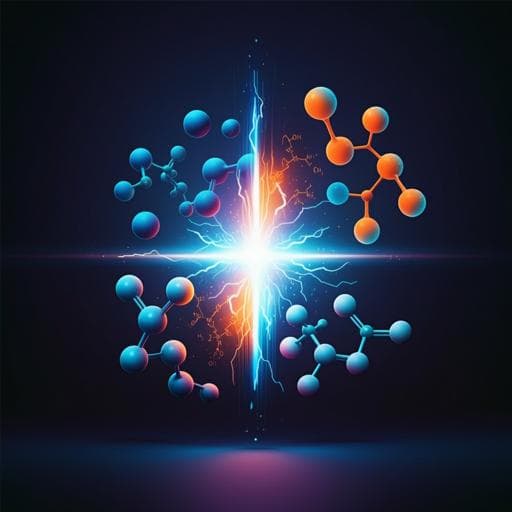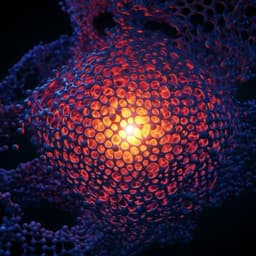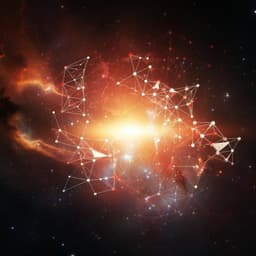
Chemistry
Nickel catalyzed multicomponent stereodivergent synthesis of olefins enabled by electrochemistry, photocatalysis and photo-electrochemistry
C. Zhu, H. Yue, et al.
Discover a groundbreaking three-component, reductive cascade reaction for arylalkylation of alkynes, developed by Chen Zhu, Huifeng Yue, and Magnus Rueping. This innovative approach yields a variety of trisubstituted alkenes with unparalleled chemo- and stereoselectivity, showcasing exclusive formation of *E* and *Z* isomers through distinct electrochemical and photocatalytic methods.
~3 min • Beginner • English
Introduction
Trisubstituted alkenes are key motifs for drugs, materials, and fine chemicals, yet stereoselective and stereodivergent access (both E and Z isomers) remains difficult. Multicomponent alkyne difunctionalizations provide a direct route to these structures, but existing methods often furnish only one stereoisomer or require stereodefined starting materials. Photocatalysis and electrochemistry have emerged as powerful platforms for enabling single-electron transfer processes under mild conditions and can be combined with transition-metal catalysis to expand reactivity. The authors sought a general, stereodivergent, three-component arylalkylation of alkynes to access trisubstituted alkenes wherein stereocontrol could be switched by changing the activation mode. They hypothesized that electrochemical nickel catalysis via a reductive pathway could generate alkyl radicals from alkyl halides and avoid late-stage energy transfer that causes E→Z isomerization in photoredox/Ni systems, thereby enabling anti-addition (E) products, while photoredox/Ni conditions could favor syn-addition (Z) products.
Literature Review
Prior work established multicomponent reactions for alkyne difunctionalization and classic olefination strategies (e.g., Wittig), yet few methods provide both Z and E trisubstituted alkenes. Metallaphotoredox and metalla-electrocatalysis have enabled diverse cross-couplings under mild conditions via SET, with photocatalysis also enabling energy transfer (ET) for isomerization or unique transformations. Electrochemical oxidative cross-couplings have advanced, but reductive variants are less developed. The authors previously achieved stereocontrolled aryl sulfonylations (anti or syn) via photoredox/Ni by tuning photocatalyst triplet energy, but extending to alkylarylation required high triplet-energy photocatalysts that inevitably induced E→Z isomerization via ET, limiting access to E isomers. Traditional reductants (Mn, Zn, Mg, TDAE) under thermal conditions were ineffective for this three-component cross-electrophile coupling, and common photocatalysts gave poor reactivity or stereoselectivity, motivating exploration of electrochemical nickel catalysis to control radical generation and avoid ET-driven isomerization.
Methodology
Three complementary catalytic modes were developed for the nickel-catalyzed three-component arylalkylation of alkynes: (1) electrochemical nickel catalysis (for anti-addition, E), (2) photoredox/nickel dual catalysis (for syn-addition, Z), and (3) photo-assisted electrochemical nickel catalysis (for syn-addition, Z without photocatalyst).
- Electrochemistry: Typical setup used a dry 5 mL vial with NiBr2-d(4-OMe)-bpy (10 mol%), TMEDA (3 equiv), and tBu4NBr (2 equiv) in anhydrous, degassed DMA (4 mL). Electrolysis at constant current (4 mA) for 16 h was conducted with a graphite anode and nickel foam cathode. Substrates: aryl bromide (0.2 mmol), terminal alkyne (0.4 mmol), and tertiary alkyl bromide (0.6 mmol). Workup included aqueous quench and extraction, followed by silica gel chromatography.
- Photoredox/Ni dual catalysis: Conducted in DMA (1 mL) with NiBr2-d(4-OMe)-bpy (10 mol%), photocatalyst Pc1 (1 mol%), PMDTA (3 equiv), and LiCl (3 equiv). Substrates: aryl halide (0.4 mmol), alkyne (0.2 mmol), alkyl bromide (0.6 mmol). Irradiation with a 45 W 440 nm blue LED for 16 h at room temperature with fan cooling. Standard extractive workup and chromatography.
- Photo-assisted electrochemistry: Identical electrochemical setup but operated at 6 mA under simultaneous 390 nm irradiation (two 52 W PR160-390 nm LEDs) for 48 h, or sequentially by performing electrolysis then irradiating the crude mixture with 390 nm LEDs. Conditions: NiBr2-d(4-OMe)-bpy (10 mol%), TMEDA (3 equiv), and tBu4NBr (1 equiv) in DMA (4 mL). Standard workup.
Mechanistic studies: Radical trapping with TEMPO or 1,1-diphenylethylene fully suppressed product formation, and tert-butyl addition to 1,1-diphenylethylene was detected by GC–MS, supporting alkyl radical intermediates. Stern–Volmer experiments showed PMDTA quenched Pc1; substrates did not. Cyclic voltammetry indicated PMDTA (E1/2 = 0.63 V vs SCE) and TMEDA (E1/2 = 0.62 V vs SCE) are oxidizable by Pc1 or the anode. UV/Vis and fluorescence data revealed the E isomer absorbs/emits more strongly at 390 nm than the Z isomer, explaining selective E→Z isomerization upon 390 nm irradiation without photocatalyst. A NiII/NiI/Ni0/NiI/NiII cycle with SET steps is proposed, with ET or direct excitation responsible for late-stage E/Z isomerization in photo-involved pathways.
Key Findings
- Stereodivergence by mode switching: Electrochemical Ni catalysis affords anti-addition trisubstituted alkenes as pure E isomers, while photoredox/Ni catalysis yields syn-addition products with high Z selectivity. Photo-assisted electrochemistry (390 nm) also provides syn/Z products without an added photocatalyst.
- Benchmarking (model system): Thermal reductants were ineffective (Mn: 7% yield, pure E; Zn: 27% yield, pure E; Mg/TDAE: 0%). Common photocatalysts gave low yield or poor Z-selectivity: [Ir(dFCF3ppy)2dtbbpy]PF6 (37%, 75:25 Z:E), Ru(bpy)3(PF6)2 (2%, 0:100 Z:E), 4CzIPN (32%, 15:85 Z:E), Eosin Y (11%, 8:92 Z:E). Optimal photocatalyst Pc1 delivered 79% yield with 95:5 Z:E. Electrochemistry delivered 72% yield, pure E under 4 mA, graphite(+)/Ni foam(−), TMEDA, and tBu4NBr.
- Broad substrate scope and functional group tolerance: Numerous aryl bromides (including ketone, ester, cyano, sulfone, CF3, OCF3, SCF3, aldehyde), di-/naphthyl, bicyclic and heteroaryl partners participated with high chemo- and stereoselectivity. Terminal alkynes bearing electron-donating/withdrawing groups and sensitive handles (BPin, chloride, free OH) were compatible. Linear and cyclic tertiary alkyl bromides with diverse motifs (phenyl, ether, phthalimidyl, ester, probenecid) coupled efficiently.
- Photoredox/Ni scope: Electron-poor aryl halides, electron-rich heterocycles, and complex motifs delivered products in good to high yields and Z-selectivities. Ortho-substituents on the alkyne aryl ring gave exclusively syn/Z products. A vinyl alkyne afforded moderate stereoselectivity (e.g., 69:31).
- Isomerization control: 440 nm + Pc1 or 390 nm irradiation without photocatalyst efficiently converts E→Z; Z does not revert to E. Spectroscopy supports preferential excitation of E at 390 nm (higher absorption/emission than Z).
- Photo-assisted electrochemistry: Combining electrolysis with 390 nm light enabled Z-selective products without photocatalyst, either concurrently or sequentially (electrolysis first, then irradiation). Substrates that failed under photoredox/Ni (e.g., alkynes with free OH) succeeded under photo-assisted electrochemistry with high Z selectivity.
- Synthetic utility: Gram-scale reactions for both E and Z isomers proceeded without loss of yield or selectivity; Z product could be isolated in pure form after a single recrystallization from a 93:7 mixture. Late-stage derivatizations of the trisubstituted alkene (fluorinative alkoxylation, electrochemical hydrogenation, photochemical trifluoromethylation, epoxidation, vinyl C–H bromination) delivered products in good to excellent yields.
Discussion
The study addresses the long-standing challenge of stereodivergent synthesis of trisubstituted alkenes via a single set of starting materials. By decoupling radical generation modes, electrochemistry avoids energy transfer-driven isomerization and steers the reaction to anti-addition (E), while photoredox conditions intentionally leverage SET for coupling and ET for E→Z isomerization to furnish syn-addition (Z). Spectroscopic data rationalize why E→Z occurs preferentially and why Z is thermally and photochemically persistent under the conditions studied. The complementary strengths of electrochemistry (tunable redox inputs, heterogeneous electron delivery) and photocatalysis (excited-state ET/ET energy transfer) provide a flexible, general platform to control olefin geometry. Mechanistic evidence (radical trapping, Stern–Volmer, CV) supports alkyl radical participation and a NiII/NiI/Ni0 catalytic cycle, with redox events mediated by electricity or light. The practical scope, tolerance to sensitive functional groups, and scalability underscore the method’s relevance for complex molecule synthesis and late-stage diversification.
Conclusion
A three-component, reductive cascade arylalkylation of alkynes has been developed that enables stereodivergent access to trisubstituted alkenes. Electrochemical nickel catalysis provides E isomers with excellent selectivity, photoredox/nickel dual catalysis delivers Z isomers with high stereocontrol, and photo-assisted electrochemistry achieves Z selectivity without an added photocatalyst. These complementary activation modes offer a unified strategy for controlling alkene geometry under mild conditions, expand the toolkit for multicomponent cross-couplings, and are applicable to complex and functionalized substrates with scalability. Future work could further broaden substrate classes (e.g., secondary alkyl halides, internal alkynes), optimize efficiency for challenging substrates, and elucidate detailed mechanistic steps and energy transfer pathways to refine stereocontrol.
Limitations
Some substrates exhibit reduced efficiency: ortho-substituted aryl bromides show lower yields than para analogs; certain di- and naphthyl bromides give only moderate yields. A vinyl alkyne provided only moderate Z-selectivity (e.g., 69:31). Photo-assisted electrochemistry can require prolonged irradiation (up to 48 h) and specialized light/electrochemical setups. Additives are important for optimal performance (e.g., LiCl improved yields under photoredox/Ni), and reaction performance may be sensitive to steric effects and substitution patterns.
Related Publications
Explore these studies to deepen your understanding of the subject.







